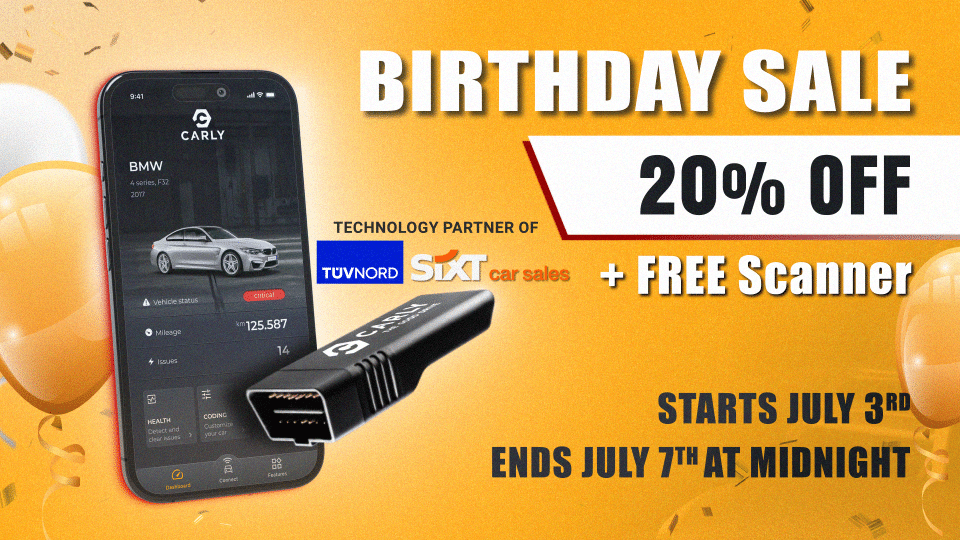There is growing interest among car owners to understand their vehicles and the on-board systems that govern their regular operations. There are also those who like to view the errors that can occur, and correct minor errors by themselves in order to avoid expensive and unnecessary trips to workshops for small matters. Now, there is a steadily growing demand for OBD diagnostic devices, Audi diagnostic tools, and OBD scanners. Here, we focus on the subject of OBD and OBD2, the options available for self-reading errors as well as other possible features, and how you can use such devices with your Audi.
When it comes to an Audi diagnostic tool, on-board diagnostics is responsible for monitoring almost all processes and procedures in a car. The on-board control units are linked together and monitored, recording any errors that may occur for further analysis. Initially, OBD focused on emissions control systems, but its reach has extended to almost all in-car systems, such as air conditioning, infotainment, and the body control system. The current standard is OBD2, and OBD3 is in development to address the future of mobility, including autonomous vehicles.
In this article, we will delve deeper into the functions of OBD in your Audi and also give you helpful tips to get more out of your car.
The Evolution of OBD and OBD2
Emissions standards in the USA became increasingly stringent in the eighties, led by California in particular. Therefore, a mechanism was developed to monitor a car’s emissions control systems and alert the driver via a signal lamp on the dashboard if there was a malfunction in the emissions control system. Hence, OBD came into the picture in its initial iteration of OBD1. However, automakers decided to create their own iterations, which caused much confusion and difficulty for those who had to manage systems across multiple brands, as reading out the fault memory was impossible unless you had a device from each manufacturer. So, the California Air Resources Board said in 1994 that any vehicle built from 1996 onwards should be equipped with the newly developed and standardized OBD2 system. OBD2 brought a standardized interface and increased the gamut of vehicle control systems that could be monitored. This means — in theory — that any workshop with a decent OBD2 scanner could read the fault memory of cars across multiple brands and determine faults with not only the emissions system but other vehicle systems as well.
While this system has been prevalent in the US since the late 1980s, Europe jumped on the bandwagon in the early 2000s with the Euro III emissions standard. OBD2 was adopted as the control and monitoring system, and since then, any gasoline vehicle from Europe that was built after 2001 must have an OBD2 system. This regulation was implemented in 2004 for diesel engine vehicles as well.
With the new unified standard, the life of auto mechanics in workshops across the globe has been made significantly easier, and reading out fault memories is much faster than before it was introduced. However, a further positive side effect is that it proved useful for the private owner. Initially, the indication of the engine control or check engine light meant a visit to the workshop was due, regardless of whether the problem was major or minor, as the owner had no way to check. Therefore, an owner could waste time and money only to discover that it was a trivial error. With the introduction of many consumer-grade OBD scanners and diagnostic devices, owners can now carry out an initial error analysis using a suitable OBD adapter and diagnostic device and determine the seriousness of the error.
Why Is an OBD Scanner Required to Read Out a Diagnosis?
The OBD interface (OBD2) is a standardized interface that works in broadly the same manner across every modern car. In order to access it via the OBD port, an OBD device is required that facilitates connectivity between the car’s control units and the respective diagnostic device
How Is the OBD2 Interface Structured?
We’ll be getting a little technical here so that you can understand exactly how OBD works. The OBD2 interface is a 16-pin socket with different tasks. While there is a standard set of poles that must be uniform across all vehicles, there are also seven poles that can be customized according to the manufacturer. For this reason, the pole assignment at Audi is not necessarily the same as at BMW, for example. The assignment for an Audi diagnostic tool is as follows:
Pin 2: J1850 Bus +
Pin 4: vehicle ground
Pin 5: signal ground
Pin 6: CAN High (J-2284)
Pin 7: ISO 9141-2 K output
Pin 10: J1850 bus
Pin 14: CAN LOW (J-2284)
Pin 15: ISO 9141-2 L output
Pin 16: Battery voltage + 12 V
For Pin 7 and pin 15, the K and L lines are used for communication between the control unit and a connected reading device via the OBD adapter. The transmission rate during communication is around 10.4 kilobits per second (kbps).
As a rule, the control unit is triggered with the L line. The data is transmitted via the K line. However, there are also car manufacturers and models where this is different, such as an Audi A4 (8E). Instead of a K and L line, this car has a KL and KKL line, i.e., two K lines. The functionality is the same as with the usual K and L lines, but the manufacturer does not use an L line for data transfer here but of a KKL line. This is especially the case with built-in sockets from Ross-Tech.
Which Error Codes Can Be Read With an OBD Scanner or Audi Diagnostic Tool?
As a rule, with a typical OBD scanner for private use, you can only read standardized error codes that all vehicle manufacturers use, unless the scannerhas been designed to accommodate the reading of manufacturer codes as well. The structure follows a uniform system with a letter and four numbers that provide information about errors in the sensors and electronics. The common codes for determining the location of the fault via an Audi diagnostic tool are as follows:
· Code “Pxxxx” = Powertrain (drive train)
· Code “Cxxxx” = chassis (running gear)
· Code “Bxxxx” = Body (body)
· Code “Uxxxx” = User Network (networks)
The error group in the second position is structured as follows:
· P0xxx manufacturer-independent
· P1xxx manufacturer-specific
The vehicle assemblies are in the third position:
· 0 means the overall system
· Px1xx indicates an error in the secondary air/air mixture preparation
· Px2xx stands for a fault in the fuel system
· Px3xx affects the ignition system or indicates combustion misfires
· Px4xx stands for all additional systems for emission monitoring
· Px5xx indicates a problem with the cruise control / idle speed control
· Px6xx stands for the on-board computer and its input/output signals
· Px7xx concerns the gearbox
Positions 4 and 5 are the consecutive component numbers.
At Audi, for example, an error code means:
· P1752 a fault in the power supply
· P0230 a fault in the primary circuit in the area of the fuel pump
· P0301 detected a misfire
However, you should note that not all codes apply equally to all models and that there are differences here. Cheaper consumer devices may only present the raw code, and you must turn to the internet for assistance on what it means. Better consumer devices from quality manufacturers will explain the error to varying degrees, as well as indicate its severity.
What Can OBD Do For an Audi Vehicle?
As already mentioned, OBD was developed to monitor the exhaust gas and emissions of cars and, at the same time to ensure the functionality of the installed components. With a suitable diagnostic device and the appropriate adapter (if needed), you can also view any errors by yourself. For this, you have to connect the OBD diagnostic device to the car’s OBD socket. Start the engine and activate the corresponding diagnostic function on the diagnostic device. Reading out codes should not take longer than a few minutes. Once the process is complete, the various error codes will be displayed on the attached diagnostic device’s screen.
In addition to displaying the errors, some devices now offer the option of deleting the error codes. However, extreme caution is required here. This is because the manufacturers of the devices do not have a built-in warning function that provides information about the consequences and effects of an improper error. In addition, the errors are not always properly deleted, and this can lead to bigger problems than before. You need to ensure that the error has been rectified before deleting the code, or else the car will mistakenly assume a system is functional when it is faulty. If you are unsure, consult a professional.
What OBD Diagnostic Devices Available for Audi?
Due to the growing interest in OBD devices, there are now a wide variety of models in different price categories on the market. There are tablet devices with their own display, diagnostic softwares that is installed on your own laptop, or apps for smartphones and tablets
Tablet Device with Its Own Display
Tablet-style devices with their own display are widely available on the market in wired as well as wireless forms. These are dedicated devices that can be operated by touch screens or buttons. They offer numerous settings, thorough error analysis, and a wide range of functions. However, you will need some basic knowledge of vehicle diagnostics when using them. Furthermore, while they might display the source of an error, you may need to perform further research to identify the causes.

Advantages:
· Single device
· Large range of functions
· Simple handling and operation
Disadvantage:
· Can be costly for a large range of functions
· You may not want to carry this device with you at all times
· Not all manufacturers offer software updates
Laptops
Another option, which is a bit more expensive, is to purchase special software for a laptop. The laptop must be connected to the car with an OBD cable to diagnose the problem. Many software manufacturers not only offer error analysis with their products but also error deletion. A number of software solutions also allow various vehicle settings, such as blinker intervals, to be coded. Software solutions can handle a wide variety of makes and models, which could turn your laptop into the perfect Audi diagnostic tool. But, the feature set varies from manufacturer to manufacturer. Your laptop will be tethered to the car by the cable during operations, and you may need internet connectivity as well.
Advantages:
· Numerous options that go far beyond simply reading out an error
· Easy viewing on the laptop’s large screen
Disadvantages:
· In most cases, the software is significantly more expensive than a simple diagnostic device
· Many manufacturers only offer licenses for one year. In order to be able to continue using the range of functions, the software must be extended annually
· Due to the wide range of options, such as recoding vehicle settings, the software is not really suitable for beginners
· There may not be free trial versions, so you may have to purchase in order to try out
Smartphone App
Here is a solution that you can carry around at all times. There are mobile apps for smartphones and tablets such as Carly, which wirelessly communicates with the Carly Universal OBD Scanner. Before purchasing an app solution, you should check if it supports your vehicle’s make and model and works as an Audi diagnostic tool. However, versatile apps like Carly support a broad range of makes and models, including Audi.
Advantages:
· Apps are easy to install on a smartphone
· The smartphone is always with you
· The manufacturers provide regular updates
· Many manufacturers offer a free trial version to test compatibility with your own vehicle
Disadvantages:
· Apps are not necessarily an inexpensive solution
· A suitable adapter is always required to use an app.
· Not all apps can be used for all operating systems.
· Not all functions of an app are equally available for all manufacturers and models. Therefore, the possible range of functions should be checked carefully before purchasing
How Does Reading Out the Error Memory Work With a Diagnostics App?
Diagnostic apps offer a wide range of possibilities and tend to vastly differ in terms of functionality and cost. With the simplest of devices, you can only display error codes and reset the error memory (delete codes).
However, advanced apps can offer a powerful set of functions with user-friendly interfaces and dedicated scanners that ensure smooth and error-free communication between your car and the app.
In summary:
· Diagnostic apps read out a car’s fault codes using a smartphone or tablet
· You gain access to the car via the OBD port
· A device is required to transfer the data to the mobile device via Bluetooth or WiFi
· Error codes can be displayed, interpreted and, sometimes deleted
· Some applications also allow certain settings in the vehicle to be coded, such as the flashing intervals of the blinkers, among other things
While some applications only offer a pure error readout, there are also manufacturers who use their app to provide diagnostics and even useful safety information. One of these apps is the Carly app.
Reading Out the Error Codes of an Audi with Carly
Carly is an extremely powerful app that has a comprehensive set of functions. The most basic one is the reading out of error codes from the fault memory of your car with a dedicated Audi diagnostic tool. Once the scanner has been installed in the OBD port of your Audi (you can check your car’s user manual if unsure where this is) and the diagnostic scan has been run, Carly will display all detected errors, whether they are minor or major. Carly will also warn you about significant errors that require immediate attention, as well as those of moderate importance that should be addressed in the near future. You can also delete errors and clear the fault memory with Carly but use this with care, as we have mentioned previously in the article.
What’s the Carly Used Car Check?
The Carly Used Car Check is a powerful function that allows you to determine if a used car you are interested in purchasing has had its mileage doctored. Sadly, there are people out there who turn back the odometers on cars so that they reflect a lower mileage than the actual situation. However, a car stores its mileage across many control units. Carly performs a comprehensive check across all control units and will warn you if there are mileage discrepancies. Sometimes there are legitimate reasons why mileages may vary, such as replaced engines, but these must be documented and noted in the vehicle registration documents.
[irp]
Carly Opens Up the World of Coding
Modern cars have a vast array of customizable features available in their control units which are modular across brands belonging to the same group, such as Seat, VW, Skoda, and Audi, which are all under the Volkswagen Audi Group (VAG). Coding allows you to customize certain aspects of your car, such as disable the automatic start-stop of the engine, adjust the duration of the Welcome Lights, change the blinker behavior when locking and unlocking the car, automatically raise the windows when the car is locked with the key fob and many more. Coding allows you to personalize your car to your liking.
Carly offers the free Carly version of the app where you can view the options available for your car before determining if Carly is the best solution and purchasing the full version of the Carly app.

Real-Time Monitoring
Carly offers real-time monitoring as well, allowing you to dynamically monitor certain parameters of your vehicle in real-time for the sake of interest or to adjust your driving habits to save fuel, for example. Parameters that can be monitored in real-time depend on manufacturer and model and include:
- Engine/hybrid system load in %
- Temperature of the coolant
- Speed in RPM
- Voltage in V
- Fuel consumption per 100 kilometers
- Engaged gear
- Speed with currently valid speed limits
- Outside temperature in ° C
Conclusion
The Carly app is truly a useful app. It allows you to read out errors, identify their severity, delete them once the fault has been rectified, and tells you about the health of your car. You can personalize your car to your liking with the coding function, monitor real-time parameters, and get help with buying a used car through the Carly Used Car Check. We recommend giving the free version of the Carly app a try first and determine if Carly is the best diagnostic and customization companion for your Audi. The Carly app will be a boon, as you can reduce workshop time and cost while knowing when your car needs a visit to the workshop too.


